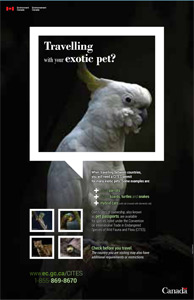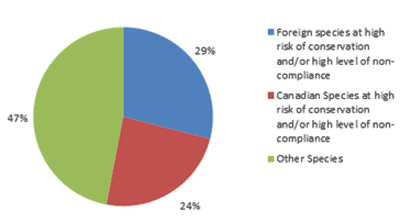Wild animal and plant trade and protection regulations: 2015 annual report: chapter 4
4 Compliance promotion and enforcement of Convention for International Trade in Endangered Species of Wild Flora and Fauna (CITES) and WAPPRIITA
4.1 Compliance promotion
Environment and Climate Change Canada (ECCC) works in partnership with a broad range of enforcement partners to secure compliance with WAPPRIITA. These partners include the Canada Border Services Agency (CBSA), Fisheries and Oceans Canada, Transport Canada, the Royal Canadian Mounted Police, the United States Fish and Wildlife Service, and provincial and territorial law enforcement bodies and conservation authorities. ECCC is also an active partner on the international stage in promoting and verifying compliance with Convention for International Trade in Endangered Species of Wild Flora and Fauna (CITES).
Compliance with WAPPRIITA is secured by such means as verifying permits, auditing importers’ and exporters’ declarations, conducting inspections at ports of entry, conducting routine or spot inspections of wildlife businesses, sharing information with border officials and other national and international agencies, gathering intelligence, and following up on tips provided by the public.
In 2015, ECCC continued to promote compliance with CITES and WAPPRIITA through more than 20 displays located at various venues, including airports, science centres, customs offices, zoos and border crossings.
A CITES poster was produced in June 2015 with the objective of educating travelling Canadians in a variety of venues such as airports, CBSA border crossings, and veterinary offices. Posters were uploaded to the CITES web site in July 2015. The CITES secretariat added thumbnails of and links to the posters on their publications page in July 2015. The Canadian Veterinary Medical Association tweeted about the poster in July 2015.
Images of the CWS CITES poster produced in June 2015

Travelling with your exotic pet?

Travelling abroad or visiting Canada?
ECCC also shared information throughout the year via its Twitter and Facebook sites. ECCC’s wildlife officers continued to give interviews, issue news releases and provide other communications materials on enforcement issues, for television, radio and print media.
4.2 Enforcement activities
Illegal trade in wildlife threatens the conservation of species and the socio-economic benefits that legal trade in wildlife can provide. Illegal trade undermines conservation efforts to manage populations, for example, through use of quotas (maximum number of specimens that can sustainably be removed from the wild population). Populations of species may be decimated by over-exploitation driven by illegal trade.
Wildlife trafficking worldwide has been increasing in value since 2005. According to United Nations Environment Programme (UNEP) data from 2014, the illegal wildlife trade is estimated to be worth $7 to $23 billion USD per year globally, and the illegal logging and trafficking of timber is valued at $30 to $100 billion USD worldwide annually. Canadian enforcement efforts are geared towards identifying and stopping high-risk shipments and investigating alleged offenders.
4.2.1 Inspections
Inspections are conducted to ensure that imports and exports of animals and plants are compliant with the requirements of WAPPRIITA.
ECCC inspected 3122 items such as passenger vehicles and trucks, people, packages, and conducted paper/administration reviews during the course of 1234 inspections under WAPPRIITA in 2015.
Inspections are either proactively planned or conducted in response to a referral from other federal departments such as the Canada Border Services Agency, other governments or the public. More than half of the inspections conducted under WAPPRIITA focused on species at high conservation risk and/or facing a high level of non-compliance. 293 were focused on Canadian species meeting these criteria, while 363 focused on foreign species. Figure 3 provides the distribution of inspections.
Figure 3. Inspections conducted in 2015 by priority

Description of Figure 3
Figure 3 is a pie chart indicating the percentage of inspections conducted in 2015 by priority. 29% were for foreign species at high risk of conservation and/or high level of non-compliance; 24% were for Canadian species at high risk of conservation and/or high level of non-compliance; and 47% were for other species.
4.2.2 Investigations
In 2015, ECCC opened 84 new investigations involving international or interprovincial movements of wildlife. ECCC publishes the outcomes of its main investigations on the Department’s website. Media releases and enforcement notifications are available online.
Four examples of investigations that led to prosecutions and resulted in convictions in 2015 for violations of WAPPRIITA or its regulations are described below.
- Illegal Import and Export of Wildlife Trophies
- Unlawful Import of Turtles and Tortoises
- Live Animal Smuggler Convicted
- Trafficking in Wildlife Products: Rhinoceros horn, Ivory, and coral
Illegal Import and Export of Wildlife Trophies
On May 8, 2015, an Alaskan outfitter was fined $20,000 in Yukon Territorial Court after pleading guilty for illegally importing and exporting wildlife, which are offences under WAPPRIITA. The fine was directed to the Environmental Damages Fund (EDF).

Wolverine
Photo: Denja1 © Thinkstock
The outfitter pleaded guilty to the illegal possession of an Alaskan brown bear (grizzly bear) hide, two black bear hides and three wolverine hides, all of which had been imported or transported in contravention of WAPPRIITA. Under the Act, it is prohibited to import an animal that was taken in contravention of the laws of another state and it is prohibited to transport an animal without a required provincial authorization or where the animal was taken, possessed, distributed or transported in contravention of provincial legislation. WAPPRIITA also controls the import, export and transport of non-CITES Canadian domestic wildlife species, such as moose, Dall sheep and wolverines. The outfitter also pleaded guilty to the illegal export of two Dall sheep from Yukon, the export of moose meat without a permit to Alaska, as well as the illegal transport of a Yukon grizzly bear hide to Alberta.
In addition to the $20,000 fine, the outfitter received a tenyear prohibition from carrying a firearm and accompanying anyone hunting in the Yukon, with a condition allowing him to hunt with a bow for subsistence beginning in 2020. The outfitter was also required to forfeit several hunting trophies and is banned for ten years from obtaining any Yukon export permits or any import or export permits.
The investigation focusing on this outfitter was led by ECCC and Environment Yukon. The case represents one element of an extensive three year multi-agency international investigation into the illegal hunting of Alaskan wildlife. ECCC, the United States Fish and Wildlife Service, Alaska Wildlife Troopers, Alberta Fish & Wildlife, and Environment Yukon collaborated on the investigation.
Unlawful Import of Turtles and Tortoises

Seized turtle shells © ECCC
On February 27, 2015, a supply company and its director pleaded guilty to six counts under WAPPRIITA for unlawfully importing protected species of turtles and tortoises without the proper permits. The company and its director were fined $12,500 and $6,250 respectively, for a total penalty of $18,750 and ordered to forfeit all items seized during the investigation.
Two sea containers originating from Hong Kong were imported by the company in October 2013 and July 2014. Upon their arrival into Canada, the containers were inspected by ECCC enforcement officers in Vancouver and Toronto. The first shipment contained 945 turtle plastrons (bottom part of the shell), 2,454 turtle shells and 52 bags of turtle shell fragments, concealed within 815 cartons. Similarly, upon inspection of the second sea container, there were 224 bags of turtle shell fragments among 842 cartons. The invoices accompanying the shipments did not list any of the animal parts. With the assistance of the Royal Tyrrell Museum of Palaeontology, located in Drumheller, Alberta, parts were identified as belonging to five species of turtles and three species of tortoise, all of which are listed under CITES. CITES-listed turtles and tortoises are popular in the pet trade.
Live Animal Smuggler Convicted
On July 22, 2015, two individuals were convicted of three counts each of contravening subsection 6 (2) of WAPPRIITA regarding a shipment of 38 animals intercepted at the CBSA port-of-entry in British Columbia on April 12th, 2012.
The individuals attempted to import animals from the United States into Canada. They were planning to open a pet store. Of these animals, three species were identified as CITES listed by ECCC Wildlife Enforcement officers, and as such required CITES permits. The animals were emperor scorpions, red rump tarantulas, and Savannah monitor lizards. All specimens seized were forfeited to the crown.
Trafficking in Wildlife Products: Rhinoceros Horn, Ivory, and Coral

ECCC and the United States Fish and Wildlife Service Office of Law Enforcement conducted a joint investigation into the alleged smuggling of elephant ivory and Rhinoceros horn from the US to Canada. As a result of the investigation, the proprietor of an antiques company was convicted of several offences related to the trafficking in wildlife products including rhino horn, ivory and coral. Approximately half a million dollars worth of wildlife products was forfeited and the proprietor was incarcerated for 30 months in the US.
The primary subject of the investigation was arrested by USFWS in New York, after allegedly purchasing rhino horn unlawfully during a planned operation. The ECCC search warrant was coordinated to be executed subsequent to the subject’s arrest. ECCC Wildlife Officers conducted the search warrant with assistance from the RCMP, a contracted forensic computer search expert, and a Chinese language interpreter.
Evidence supporting the suspected illegal import and sale of rhinoceros horn and elephant ivory were discovered and seized during the warrant, in addition to documentary and computer evidence. Wildlife Officers also discovered and seized a large amount of illegal narcotics during the search. Commercial quantities of what was suspected to be Ecstasy/MDMA, Marijuana, and Cocaine or Heroin were found. Wildlife Officers transferred custody of the narcotics to the Richmond RCMP detachment drug squad and they have initiated their own investigation.
The ivory pieces and the one red coral statue seized as a result of the warrant executed at the location were transferred to the USFWS by way of Mutual Legal Assistance Treaty for use in their prosecution of the subject, and were forfeited as a result of his plea agreement and sentencing.
4.3 Collaboration with provincial and territorial partners
While WAPPRIITA is federal legislation, several provincial and territorial agencies have designated officers to enforce the Act. The collaboration between Canada and its provincial and territorial partners is advantageous because it results in better coordination of efforts and resources in undertaking wildlife enforcement actions, especially large-scale operations. As mentioned in Section 1.3 of this report, agreements and memoranda of understanding exist between ECCC and Manitoba, Saskatchewan, Alberta, British Columbia, the Northwest Territories and Nunavut to support the administration and enforcement of WAPPRIITA in accordance with their own legislation.
In 2015, ECCC developed a new pilot project: a three-pronged approach for tracking and identifying polar bear hides in trade. Passive Integrated Transponder (PIT) tagging, along with DNA analysis of muscle tissue and Stable Isotope analyses, make up the 3 prongs of this approach. The new pilot approach seeks to improve the traceability of hides throughout the life of the hide (from hunt to auction to final destination), therefore enabling better enforcement of international trade laws. Provinces and territories, along with wildlife management boards (who have management authority under the land claim agreements) support this new pilot approach. So far, training sessions for Conservation Officers who will implement the new pilot approach on the ground in Nunavut and Nunatsiavut (Labrador) have taken place. Work is underway to organize other training sessions.